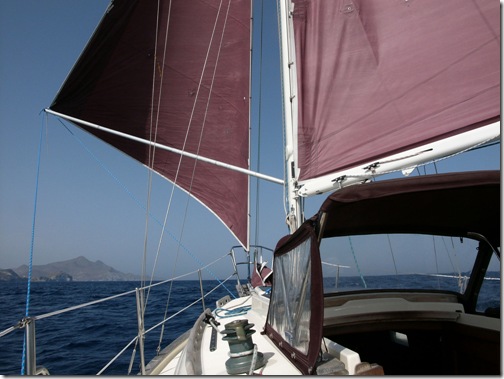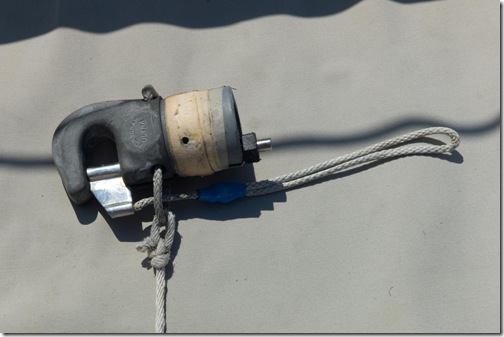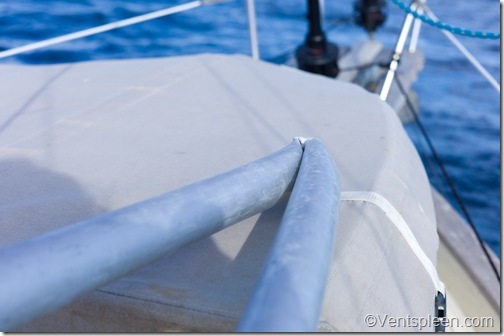Poling out the jib is a great way to efficiently use the sails you already have on your yacht. This is a great set up for downwind sailing and much easier than a spinnaker. What you need is a whisker pole. The basic difference between a whisker pole and a spinnaker pole is that the whisker pole can only work in compression. For poling out sails however a whisker pole is all you need as it is always trying to be compressed.
Forespar make a range of aluminium whisker poles. I chose a 2” dia. version in three parts with a total extended length of 200” (5 m) and a collapsed length of 80” (2 m) (model no: ADJ-15-DL) On each end is a self latching spring fitting. Apparently it is strong enough for a 28 foot boat to use it on the working jib in med to heavy airs.
When not in use it lives clamped to the stanchions. It is fairly unobtrusive here but rather exposed to the weather. The pole is quite light which is helpful when using or stowing. The end fittings are made of a type of plastic so they do not damage the boat at all. The end fittings have spectra lines to open the jaws and to attach topping lifts if required. It cost 350€.
The twist mechanism is simple but it is not very reliable. Often the pole will collapse during use. I complained to Forespar who eventually sent me a new pole. Sadly that was barely better than the original one. The system works by having a rubber wheel with a slightly offset axel so that when you twist the pole, it acts like a cam and locks the pole. Eventually I was forced to drill a hole in the extended pole and fit a self tapping screw to stop the pole collapsing.
I had to mark the poles at their maximum extension so I would not pull the poles too far apart. Unbelievably, the only thing stopping the poles coming apart is a piece of dyno tape stuck onto the inside of the pole. Not surprisingly, these don’t stay in place long.
The pole is not very strong and it can bend alarmingly. I haven’t snapped it in half yet but if I was not careful I could. It’s a shame because I would like to leave it up poling out the jib but instead I have to drop the jib and use the staysail instead or risk breaking the pole even though it’s not very windy. My jib is only 150 sq feet and my boat just 24 feet long but even still, this pole is not up to it.
Even collapsing the pole is difficult. The inner pole collapses easily as there is a small hole to let air escape (if not it would be like a giant bicycle pump with your finger over one end!) but the smallest dia. pole is hard to collapse as there is no way for the air to escape except around the rubber wheel inside the pole which is too snug a fit.
Another annoying fault is that the jaw on the widest end of the pole cannot be opened if the inner pole is fully inserted. This never used to happen on the old pole so I assume it has something to do the new plastic jaws but in any case I find this a poor oversight.
I removed one end while investigating why the jaw wouldn’t open and discovered that the fitting was much too small in the tube and was made wider with masking tape! This is very poor, because in time the fitting will move, the three screw slots will enlarge and eventually there will be play in the jaws. It’s just poor engineering and there’s no excuse for it.
I wrote to Forespar who assured me that this was a perfectly fine way to build a spar, common engineering practice, I was told. Honestly, who do they think they are fooling? Sound engineering practice would have been to make the end fit the pole snugly like it does at the other end of the pole. Failing that, then a wrap of some kind of hard plastic that covered all of the jaw end that fits inside the pole would have been ok. But no, Forespar use a cheap and ordinary white masking tape which can compress and they only wrapped a part of the end fitting.
Since they managed to make one end fit well, I can only assume that this is either a design fault or bad manufacturing. If the pole worked well without collapsing I would forgive all these faults but it just doesn’t work well enough to be trusted and it’s not man enough even for my small jib.
Conclusion: Nice idea, small when collapsed but annoying to use, hard to collapse when stowing but easy to collapse when using it to pole out a sail. Not strong enough for a 24 foot boat despite the claims and poorly engineered with masking tape. Thin piece of dyno tape is all that stops the poles coming apart. All in all a big disappointment.
Update August 2011
Ooops. It had to happen one day. In just a light wind a slight sea the pole finally broke. It simply folded itself in half.
Well, the day finally arrived. The pole snapped in two. At the time I was running down wind with about 12 – 14 knots of true wind and a slight sea. One minute all was well then the next the pole had folded in half. No drama, no fuss at all. It was very undramatic.
However I do owe Forespar an apology. They did say that the masking tape was fine and that it was unlikely that the screw holes would ever enlarge in time. They were right. The pole broke long before it ever became an issue!



Yes,
these poles are crap. See below a response I did to another query about pole failure.
Before I bought this pole I did a bit of research but could not find much info on them so took a chance. Here is hoping that this info may help others choose a better option.
regards
Andrew
SV “Spice”
Dufour 50
“Hi Rick,
I found your post by accident when researching Forespar whisker pole and failures.
I have a Forespar LC15-27 telescoping whisker pole that has been an absolute disappointment. I bought it in Panama for a Pacific crossing and it has failed several times. First failure was the line control mechanism which necessitated taking apart the internals and jury rigging the pole by drilling a half inch hole and inserting a bolt to keep the pole extended, similar to another reply. All the internals were totally trashed. It then failed again when the outboard pole (smaller diameter tube) collapsed and bent double when a modest gust of wind about 20 knots apparent hit the vessel one night half way across the pacific. We had to finish the not inconsiderable voyage of about 3000nm with only a small amount of headsail which was a real piss off. When I reached Australia it took quite a lot of time, effort and expense to find the correct size alloy tubes, get them anodized and sent from one side of the country to the other Forespar honoured the warranty but the freight would of been at my expense so it was not economical for them to supply the alloy tubes. I then recently did a passage from Australia to Fiji when the internal line control mechanism again failed again in modest winds. I did modify my usage of the pole to try to reduce the loads as I thought the problem may be user error however even with babying the pole it still failed. I am convinced now that these poles are only for light weather and do not belong on a cruising yacht where many miles are traveled and a squall or worse can easily be experienced. The other problem i have had is with the outboard pole end regularly chewing up headsail sheets. It only takes about 24 hours even in light winds before the sheets get chafed.
I have attached a drawing of the pole mechanism that should help in pulling it apart and understanding the working of it. It sounds as if the “Stinger tube” has bent which would explain the difficulty in movement. There is a lot of compression on this tube as it takes twice the compression loads of the pole ends. In fact my “Stinger Tube” now looks like a piece of soggy spaghetti with all the bends in it from compression even though I used a tube with 33% greater wall thickness than original as that is all I could find.
To pull the pole apart requires drilling out the rivets that hold the black nylon guides where the tubes meet and moving the inserts apart, than removing the outboard ends. Easier said then done as my pole even though only 2 years old had seized screws due to stainless Vs Alloy. Forespar did not use antiseize on these parts which is pretty slack. I had to drill several out.
Good luck with it. Personally I am going to get rid of this pole and buy a fixed pole at “J” and put up with reduced performance. They may be good in theory but the practice is the reverse.
regards
Andrew
SV “Spice”
Australia”